

Aim: To determine the ability of dental students for tooth shade matching in both bench and patient setting with the level of training.
Material and Method: Shade matching, training and testing using Ishihara test was conducted for 380 students of Indian origin currently studying in a teaching dental institute and results were calculated for the same, testing their ability to correctly match tooth shade with and without training.
Results: The study comprised a majority of females 80.8% (n=307) subjects while there were 19.2% (n=73) males. After statistical analysis, it was found that the scores of subjects with training showed a statistically significant difference from the scores obtained by subjects in the untrained group (p≥0.0001). Trained subjects scored better in both the tab test and the clinical setting than the untrained subjects.
Conclusion: It was concluded from the study that training significantly improved the shade matching ability of the subjects in both bench setting as well as clinical scenarios.
Clinical Significance: The findings of this study highlight the existing problem associated with basic colour science knowledge. It indicates the importance of education regard to tooth shade matching, which is considered a major component of a successful dental practice.
Key words: Shade matching, colour guide, Ishihara test, colour education.
Shade selection plays a significant role in deciding the esthetics of the patient. Understanding colour is the most important aspect of shade selection. Shade selection is a crucial step as no tooth is of uniform shade and selecting shade in traditional sense is a very subjective practice even among most practiced clinicians. Selected shade varies from individual to individual, also it varies time to time, i.e. if the same individual matches the shade on two different occasions it may still vary. Because of the subjective nature of perceptual shade matching, the ability to match shades is acquired through knowledge of basic colour principles and clinical experience.1 Ideally the process of shade selection should be a collaborative effort between the patient and practitioner. However, ultimately it is up to the dentist to use his experience to properly guide the patient in proper shade selection of the restoration to ensure a mutually satisfactory final outcome. As visual shade matching has remained a skill acquired through education and experience, lack of awareness among students regarding possible colour defective vision and lack of colour education and training including inappropriate usage of tools is also responsible for diminishing the esthetics in dental procedures.
Many factors influence our ability to achieve accurate shade-matching results, including subjectivity, shade-matching tools, materials, methods, and conditions. Nonetheless, the importance of colour education and training should not be underestimated, as Sproull noted in 1973: “The technology of colour is not a simple matter that can be learned without study; neither is it a complicated matter beyond the comprehension of dentists.”2 Bergen said “colour is unimportant to physiological success of dental restoration, yet it could be the controlling factor in overall acceptance by the patient.”3 The literature shows that dentists often overestimate their colourmatching and reproduction abilities. When asked to match 16 corresponding pairs from two Vitapan Classical shade guides using the visual method, the pre- and postdoctoral participants correctly matched only 50%.4 In another study, which closely resembled clinical dentistry in that there was no exact match, the observers’ choice was the second or third best match.5,6
Influence of years in practice, specialty and racial and ethnic differences have been reported making education in colour science a pertinent first step in a dental professional’s effort in achieving better results in shade matching and reproduction.
In the present study, shade matching, training and testing is done for the dental students followed by the comparison of trained and untrained subjects with their testing ability for shade matching.
The study was conducted in the Department of Prosthodontics and Crown and Bridge and Implants, Manav Rachna Dental College, Faridabad. The study was conducted in 380 students of Indian origin currently studying in a teaching dental institute. The participants were seated at a constant distance and made to read the Ishihara test plates, participants testing positive in the Ishihara test and participants having more than 2 incorrect answers in the trained group, on a single day of training out of three training days were excluded from the study. The purpose and nature of the research procedure to be performed was explained adequately in subjects own language. The Informed Consent Form was signed and explained to each participant before starting the procedure. 380 students took part in the investigation and were be divided into 2 groups-Calibrated/Trained & Non–calibrated/Untrained.
All the participants in both the groups (trained, untrained) were asked to fill a questionnaire. The questionnaire comprised of two parts; first part consisted of bio-data, and the second part consisted of Ishihara test. The Ishihara test was done using the plates given in the Ishihara booklet.
The participants were asked to view each plate from a distance of 75 cm and plane of the paper is at right angles to the line of vision (fig 1). The numerals which were seen on plates were stated in the answer sheets provided and each answer was to be given without more than three seconds delay.
The training on day 1 began with a presentation lecture of 20 mins on tooth shade and its components value, hue and chroma. The trainees were familiarized with the concept of colour and tooth shade and how to use a shade guide in more detail than a regular class, it ended with participants taking the tab test with a vita classical shade guide, which comprised of matching the three shade tabs from one Vita classical shade guide with the other complete vita classical shade guide. On day 2, the participants were trained using interactive CD-ROM, exercises in esthetic shade matching in dentistry by Rade Paravina and John Powers. The training session ended with another round of tab test. On Day 3, more complex exercises from the same program were used to train the participants, and the session ending with the tab test taken by all the participants. Only participants scoring 2/3rd correct answers of the three days were included in the study. Rest of the 180 participants who did not receive any prior training were included in this group and performed the tasks testing the shade matching ability of the participants, directly.
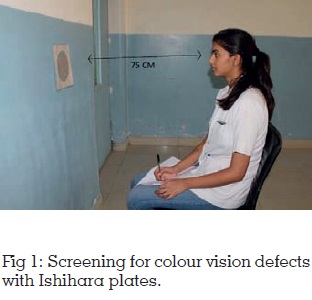
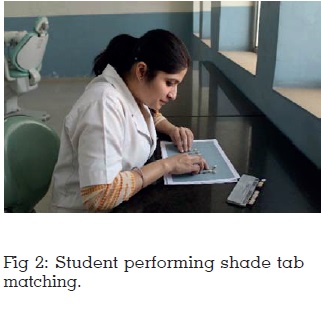
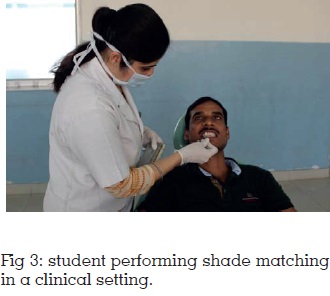
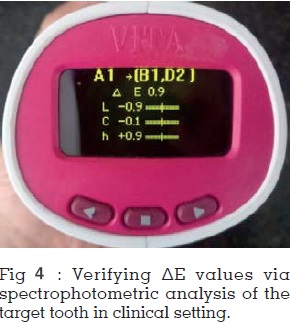
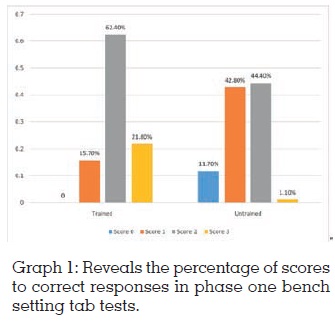
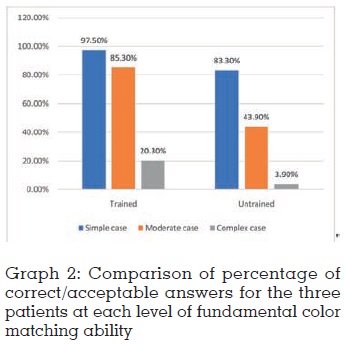
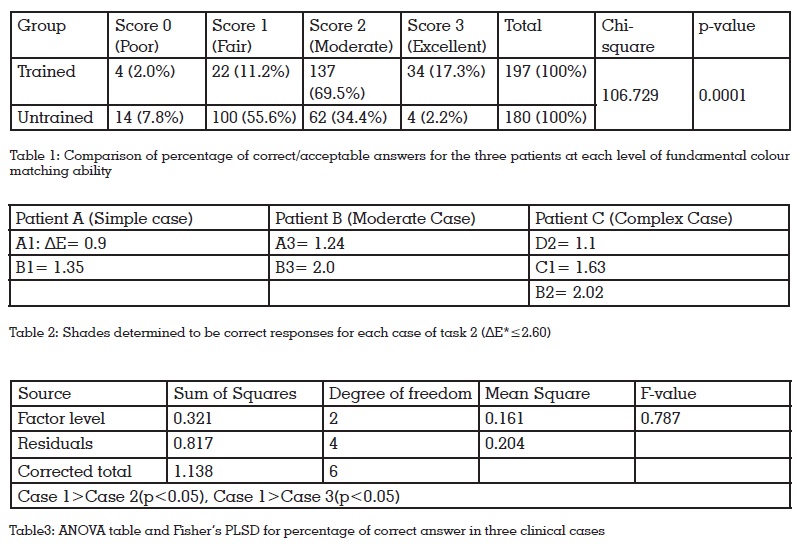
In the next phase of the study, each participant from both the trained group and untrained group, were presented with two tasks.
1st TASK (In a bench setting): Students from both groups were provided with Vita classical A1-D4® shade guide and three target shade tabs from different hue groups with shade identification numbers covered. The student’s task was to correctly match the sample shade tab with its counterpart from the shade guide. (Fig 2)
2nd TASK (In a clinical setting): The participating students were asked to find a Vita Shade match for a natural maxillary central incisor of three patients. The three patients were selected according to the tooth shade. 1st patient selected had fairly monotonous shade of the maxillary central incisor and was the simple case. 2nd patient had a polychromatic maxillary central incisor being the moderate case. 3rd patient or the complex case had a polychromatic tooth with any intrinsic staining or a line of hypo calcification. (Fig 3)
ASSESSMENT: The fundamental colour matching ability of the observers was categorized into four groups based on the number of correct answers for a shade tab matching task (Excellent: all three matches; Good: two matches; Fair: one match; Poor: no matches).
The frequency of clinically acceptable/correct answers was calculated, and these data were compared across each of the two groups and four categories of colour matching ability.
All the findings and data, for each subject were recorded in a standardised proforma, along with the subject’s before and after analysis.
STATISTICAL ANALYSIS: The data was retrieved from pre-coded survey proforma to a computer. The following methods of statistical analysis have been used in this study. The Excel and SPSS (SPSS Inc, Chicago, Version 21.0) software packages were used for data entry and analysis. Descriptive statistics for each parameter that included numbers and percentages for discrete or categorical data and averaged (mean + standard deviation) for continuous data are presented in the form of Tables and Figures. Significance for all statistical tests was predetermined at a probability value of 0.05 or less. Chi-square test was used to test association between proportions of various parameters such as tab tests after training, test scores and correct answers in bench setting and clinical setting among the trained and untrained group. ANOVA test was used to compare means of three different clinical cases in terms of complexity drawn from corresponding dental students in both the groups.
After exclusion of 3 students in the trained category after Ishihara test and tab training test, responses from 197 subjects were recorded from the trained group and 180 subjects from untrained group. For the 1st task (bench setting tab test) assessing across the two groups, percentage of subjects scoring 3 (excellent, all three correct matches) was 21.8% in trained group and 1.1% in the untrained group, 62.4% trained subjects managed a score of 2 (good) and only 15.7 % from this group scored 1(fair) whereas untrained subjects where almost equally divided in the scores 2 (44.4%) and score 1(42.8%). While none of the subjects scored 0 (poor), 11.7% subjects from the untrained category gave no correct answers for the tab test, showing a clinically significant difference in the scores to effect the role of training in shade matching. (Graph-1)
In the second task of clinical setting and shade matching on three varying cases with simple, moderate and complex tooth shade, the study revealed similar results. More students from the trained category managed to score in the moderate and excellent category with two and three correct shade matches respectively whereas more number of untrained students managed a score of 1 hence landing in the fair category as depicted in table-1.
As for this task correct/clinically acceptable shades after determination of ∆E(Fig 4) for patient A(simple case) were A1, B1 for patient B (moderate case) were A3, B3 and for patient C (complex case) were D2, C1 and B2.(table 2) assessing the trained group, 97.5 % correct responses were recorded for simple case 85.3% for moderate case and 20.3% for complex case whereas among the untrained group, correct responses recorded were 83.3% for simple case 43.9% for moderate case and 3.9% for complex case (graph 2).The data analysed across the three patients showed a statistically significant difference in the number of correct responses among the three patients (p<0.01). Table-3 show the fisher reliability analysis depicting statistically significant difference in the number of correct responses between case A (simple case) and case B (moderate case) (p<0.05) as well as between case A (simple case) and case C (complex case) (p<0.05).
On further analysis a trend towards better performance in shade matching with the training for patient C. Female students had a better performance than male students in all three cases; however, there was no statistically significant difference between the groups.
In today’s clinical practice, esthetics in general represents an outcome from patient’s perspective. Shade matching to adjacent teeth is one of the important and most challenging aspects of a successful restoration and hence correct tooth colour determination is a crucial step in successful planning and performing dental treatments.6 Selecting the shade of esthetic restorations is frequently based on visual perception by comparison with a shade guide in relation to the natural tooth. It has been an important problem for the dentists that how to accurately capture and express the natural tooth colour information. This is especially a difficult issue for students who have just come into contact with dental restorations. Most of the dental students although exposed to theoretical knowledge lack previous exposures to such practical knowledge and experiences which makes it extremely difficult for them to completely understand the concept of colour and use it to their advantage during their progressive years in clinical education. Though many suggestions have been made over the years about incorporating a comprehensive curriculum inclusive of practical colour education not many have been able to successfully follow through.
This study set out to evaluate the quality outcomes of these shade-matching procedures as performed by dental students in relation to training. About 380 students were included in the study, where 180 students made up the untrained category and 200 students were included in the trained category, for the fear of dropouts and elimination of students after the training tests. Minimum students required in the trained category were 180 and after the training was done and students finally screened we were left with 192 students in this category.
The null hypothesis was discarded after the results were obtained and based on the results, the hypothesis was confirmed. A significant improvement of colour differentiation with Vitapan Classical shade guide could be achieved and determined by the curricular training programme.
The present study supports the favourable role of education and clinical experience in tooth-shade matching by dental students. Dental students represent a suitable population to test shadematching abilities, because they are usually young adults in the same age range, have some or no experience in colour matching, and are likely to have fewer systemic conditions that might affect shade perception. Studies7 have reported a small, nonspecific decrease in the response of the visual system to luminance and colour contrast with increasing age. The present study was conducted with students aged 20-24 years, representing an age range associated with the most-accurate colour perception and discrimination hence the fear of inability to choose correct shade is reduced simultaneously reducing other such confounding factors.
Colour blindness is a hereditary disorder linked to the X chromosome, men are 10 to 20 times more prone to having the deficiency than women8, which was also found to be valid in the current study as one male student was excluded from the sample for being colour deficient, screened using Ishihara test. Moser9 in evaluating a group of 670 dentists, verified that 10% had some type of deficiency related to shade perception. This condition affects the ability to discriminate shades, which is in agreement with other studies.8,10
Various studies have shown a significant role
played by experience in developing an acumen for
shade matching in students11-13, Della Bona et al.14
reported that previous training in shade matching
and experience in dentistry had important roles in
correct shade matching. were found to be directly
related in line with the current study conducted
that shows training has a statistically significant
outcome in the number of correctly matched
responses by the students in trained group (62.4%)
than the students in untrained group (44.4%) who were not exposed to the shade matching specific
training earlier. Hence we are drawn to believe
that training is one of the controllable factors which
strongly influences the correct shade matching by
the dental students.15,16
In this study, the shade tab matches are the identical
shade tabs in the complete shade guide. The match
was confirmed with a dental spectrophotometer,
and the colour difference ∆E* value between each
target tab and corresponding tab in a complete
shade guide system was less than 0.5—a colour
difference that is imperceptible.17 This kind of
colour test was a first experience for most of the
participants and the translucent nature of porcelain
separates this task of matching tabs from any
other colour matching task. Also, colour gradation
from incisal to cervical areas of the shade tab
complicates the matching process. For the natural
tooth colour matching task, the conditions are
further complicated. Spectrophotometer was
used to determine the correct response for the
patient tooth colour. There are many studies on
perceptibility and visual acceptability thresholds.
The data also suggests that the students from
the trained group had difficulty in identifying the
correct hue group but were more successful in
staying close to the correct values and chroma,
whereas the untrained group had a more difficult
time identifying the value but their matches tend
to remain in the same hue group which was in
accordance to a study done by Winkler et al
where it was concluded that students had the
most difficulty determining the correct hue group
for the shade tab. Incorrect responses tended to
remain in the same value and chroma range but
were selected in a different hue group. Studies18
conducted also show that value is a more important
factor to a dental clinician than hue and chroma
in regard to shade matching of a restoration and
its acceptability by a patient, so the results of the
current study point towards the fact that adequate
training of students during their dental curriculum
can increase their sensibilities towards matching shade in a closer value than other aspects
compared to untrained or inadequately trained
students in shade selection.
The findings of this study highlight the existing
problem associated with basic colour science
knowledge. It indicates the importance of
education, which is considered a major component
of a successful practice. It was unanticipated,
however, that, even though most of the participants
were dental professionals who frequently performed shade-matching procedures, only a
few participants indicated having high confidence
in their level of knowledge. Although there has
been improvement over the years as the amount of
hours and topics dedicated to colour science have
increased, but the problem might still exist. Hence
further studies are required to understand the form
of colour education most effective for students and
ways to effectively incorporate it in the curriculum
as well as the after school programmes.